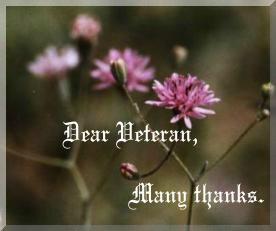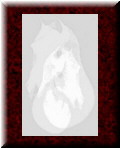
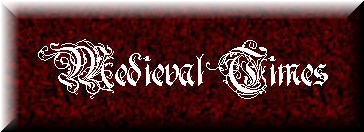
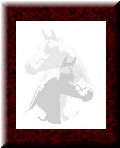
The Oxford Dictionary lists the 'Middle Ages' as being European history from about 1000 to 1453 A.D. Armor came into its own during this period and with the foot stirrup being introduced into the West during the 700's combined with the saddle giving the rider more stability with the lance produced more shock power than bow and arrow, though at a lesser range. Though the foot stirrup was in use in China by the 5th century A.D., the Chinese never satisfactorily solved the problem of nomad cavalry and were repeatedly overrun despite attempts at selective breeding and expensive importation of special breeds such as the 'blood-sweating' horses of Ferghana. (Encyclopedia Americana)
Mongol armies achieved fame with their remarkable communication and coordination of their staff, their light-armored horse archers and encircling tactics. The European knights were temporarily saved by the voluntary turnback of the Mongols, but were soon menaced by the development of weapons such as the crossbow, English longbow and armor piercing firearms. In response to these, armor became stronger and heavier, larger and slower, horses were developed to carry the new heavily armored knight. (Encyclopedia Americana)
Although heavy horses were in existance since the time of Caesar (the Ardennes is the oldest of the European draft breeds), now they went to war in great numbers carrying the heavily armored knights.
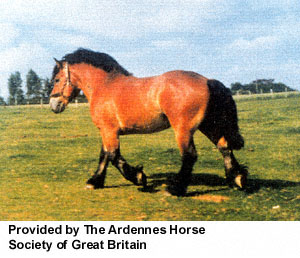
"The Great Horse of Briton" 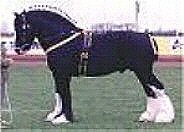 The Shire, the largest of the draft breeds. Photo from: http://www.blackforestshires.com
The Shire, the largest of the draft breeds. Photo from: http://www.blackforestshires.com
"Research shows that early Spanish horses influenced the development of the now lost Norman horses of medieval France. Norman horses infused with Barb blood contributed to the equine type that would eventually come to be known as Percheron, after the Les Perches region of France. Both the horses of Andalusia and Normandy possessed an infusion of Barb blood from the Moorish invasions. With their common oriental ancestry, breeding Andalusians to Percherons produces offspring approximating the type of the old Norman horse." (Spanish-Norman Horse Registry, Inc.)
The French knight's charger 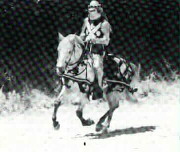 The Spanish-Norman, re-created phenotype of the extinct, Norman charger.
Photo from: http://www.spanish-norman.com
The Spanish-Norman, re-created phenotype of the extinct, Norman charger.
Photo from: http://www.spanish-norman.com
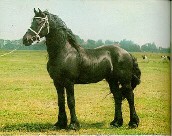 The
Friesian Horse Photo from: http://www.dread.net/~steele/fresian.html
The
Friesian Horse Photo from: http://www.dread.net/~steele/fresian.html
The Friesian horse was also used by armored knights. This breed is one of the oldest in Europe, its origens lay with the early 'cold' blooded breeds. The Friesian horse is indigenous to what is now known as the Netherlands. It was (it is thought) in these medieval times that Andalusian and Oriental blood was added to lighten this handsome breed.
About this time the Catholic church started gaining ground, and in 1096 began the crusades to 'regain holy ground' from the 'unbelievers'. Great numbers of horses and men went off to fight in foreign countries.
The later part of this period in history is marked with vast cruelty toward the loyal horse, as well as other animals. Training methods sought to shorten the training time by extremely harsh methods and severe bits and spurs were brought into widespread use. Man's 'inhumanity' towards Man was only surpassed by Man's 'inhumanity' toward Animals.
Let us not forget all those horses of any breed, or mixture thereof, who suffered from our ignorance and who fought beside us with loyalty and honor during the wars of this period, or any period in our history!
Music is an excerpt from "The Dragon's Breath" by David Arkenstone from his CD
"The Celtic Book Of Days" (Windham Hill)
Title clip art from: http://www.geocities.com/EnchantedForest/Palace/7076
and: http://www.geocities.com/Heartland/Ranch/8841
